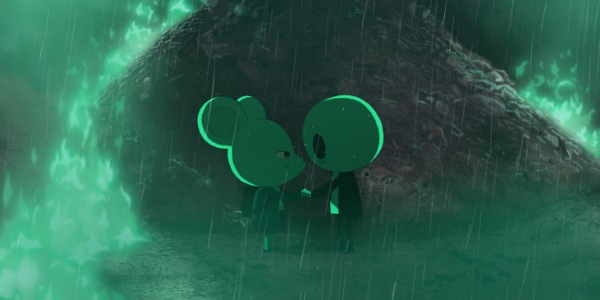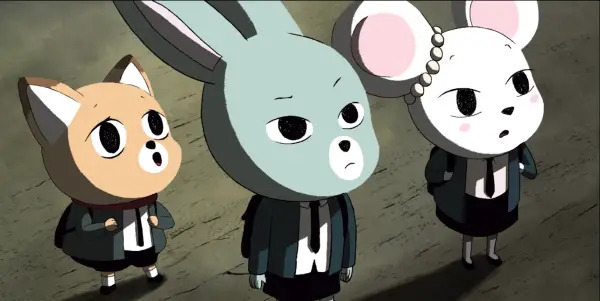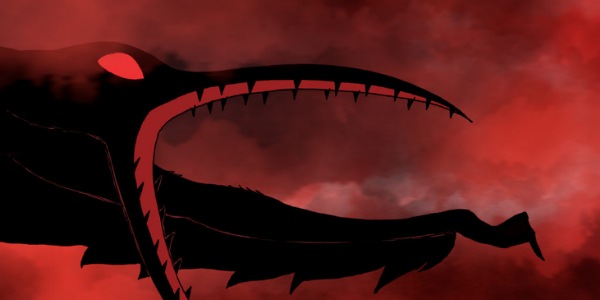Animation Sensation: BIRDBOY: THE FORGOTTEN CHILDREN

If there is one word that can sum up Dallas…
Film Inquiry introduces to you Animation Sensation! Twice a month, I will be presenting some of the most intriguing, fascinating, and fun films that the art of animation has to offer. Join me as we explore worlds that only animation can bring, but a word of warning is in order: there will be spoilers.
Based on a graphic novel called Psiconautas by Alberto Vázquez, Birdboy: The Forgotten Children is unique because he also wrote and directed the film adaptation. Most creative types do not have that kind of freedom to adapt their work adequately. The film was a critical success but bombed at the box office with a budget of 1 million only to make back $52,366. Maybe most people can’t handle an adult animated feature unless it is a comedy?
Birdboy: The Forgotten Children is a strange little animated film. Weirdness abounds in Birdboy, complete with anthropomorphized characters, seemingly inanimate objects that reveal themselves to be sentient, simplistic hand-drawn animation, and a plot that raises more questions than it provides answers. It is also a brilliant little animated film with a haunting electronica score, tragic themes, and an angsty coming of age plot. Birdboy has earned its seat in the world of western adult animation, a market empty of meaning and bombarded with rehashed adult animated comedy shows.

The story of Birdboy starts with a literal bang. The brisk-paced prologue exposits to the viewer that the once idyllic island home of several anthropomorphic animals had a nuclear meltdown that makes whatever Bambi suffered through looks like sunshine and lollipops. After the fallout, which killed most of the fish and devastated the land, the island was split into two: the fishing village, where the survivors eke out a living, and the once industrial area that is now a junk heap where Darwinism is the rule of the land. Birdman, the father of Birdboy, was once a lighthouse keeper who survived the explosion and began flying around the island carrying a satchel.
Tragedy strikes when Police shoot down birdman since he was suspected of delivering drugs across the island. In reality, the pouch was carrying mysterious glowing acorns, which his son picks up and continues where his father left off. Birdboy, on the other hand, has a curse on him—a crow-like demon that is trapped in his body after the explosion. This curse makes him enemy number one on the island. But fear not, he has some friends who still believe him, especially his girlfriend, Dinky.
A Cute Yet Despondent Coming-of-Age Fable
If Birdboy: The Forgotten Children is to be described in one word, it would be specious. Not in the sense that the viewer does not know what kind of experience they are getting themselves into. The box art of the film is imposing, menacing, and features a color palette of reds and blacks—hues commonly associated with danger, power, aggression. It’s that Birdboy’s visual sensibilities are cute, deceptively diminutive, and seem more humble in their simplicity.
The animal characters are almost all rounded in design, carrying a neotony that presents them as anything but threatening, even the criminal ones to a degree. Excluding Birdboy’s demon form, most character designs look closer to something one would find in a PBS Kids cartoon. The use of pastel colors for most of the characters has a calming glow, lulling the viewer into a false sense of security. Even Birdboy, the titular silent protagonist—constantly sporting a black suit—resembles a fun-size version of a Reservoir Dogs conman.
The cartoon regularly dashes any sense of security, often when the world of Birdboy is on display, however. The world of Birdboy is bleak, and while the character designs are cute—the world is jagged, jaded, jilted, and so are the souls of most of the characters. Beneath the veneer of cuteness lies a nihilism that juxtaposes the feeling of the central trio of the story: Dinky, Zoritto, and Sandra. The three of them have epic angst of teenaged proportions—moody, sad, and cynical, wishing nothing more than to leave the fishing island where they live.
An island that, at one time, was green and full of life and prosperity. Now the island is a dull and literal grey husk of what it once was, even the ocean; a once azure breeding ground for plenty of fish is flush of color. It’s impressive how well Birdboy: The Forgotten Children utilizes color figuratively to hammer the feeling of hopelessness into the viewer. Mental health is also touched upon in Birdboy, with several of the characters losing a grasp on reality as they try to make sense of a hostile world. And although things do take a turn for the better for several of the characters in this regard, the road to recovery is beyond bumpy.
Saint Birdboy
Birdboy: The Forgotten Children is a very Spanish film. Not only because it comes from Spain, but its themes—at least in a cultural sense—are Catholic. Despite an ever-growing secular society, Spain is still heavily entrenched in Catholic identity, and Birdboy is no exception. The eponymous character is almost mythologized within the film, to the point of being an urban legend. Most of how the other characters view him are with a sense of either fear or awe, with the local authorities trying to track him down and kill him. His goal of taking magical acorns and bringing life back to a dying island are presented in the movie as miraculous and provide glimmers of hope to an otherwise bleak world.
The theology of Catholicism is highly dependent on miracles and the faith required to make such feats of divinity possible. Putting a black suit-wearing and cute bird in the place of sainthood is a bit of a stretch, but religion is no stranger to using animals for parable’s sake. Several of the saints in Catholic doctrine were also hunted down and killed, becoming martyrs in their own right, and have as many detractors as they do believers. Despite being pessimistic and wanting to leave the island, Dinky has a close relationship with Birdboy and believes that he will return.

Some may chalk this up to foolish flights of a broken-hearted girl wanting her boyfriend back, but the film presents the idea that love is one of the highest forms of faith. Most of the other villagers believe Dinky to be a fool for believing that Birdboy will return, let alone do any good for anyone else. Still, by the end of the film, Dinky—and ultimately the rest of the village—is rewarded for her belief. Even if it means that Birdboy has to die in the process, yes, the eponymous main lead has to die for the village to be reborn. The film handles such an unfortunate event without falling prey to mawkish drama or preaching to the audience.
But faith is not the only heavy theme that Birdboy: The Forgotten Children touches upon; a quiet, youthful rebellion is also at play throughout most of the film. Dinky, Zorrito, and Sandra all want nothing more than to leave their tiny village, and such angst is typical during one’s teenage years. Whereas other films of this theme tend to present the angst-ridden teens’ desire to leave as something to cheer for, Birdboy exudes more of the feeling that such a desire is not only foolhardy—it’s impossible. Time and time again, the trio of teens have roadblocks towards leaving their humble tiny island, be it monetary or intervention from villainous characters.
So how does the trio cope with a growing sense of helplessness? by stealing money from others in hopes that they will gather enough funds to leave. But some of the other villagers have other dubious means of dealing with a growing sense of hopelessness. Birdboy: The Forgotten Children is also a cautionary tale against drug usage, and some of the side characters’ addiction to them is presented in clever allegory.

One of the main characters, a sad pig fisherman named Zachariah, lives with his mother, a drug addict. The film never explains what kind of drug or how his mother became an addict but shows the effects of drug dependency in a very insidious manner. The drug-addled mother has two personalities—her usual character is where she is a bed-ridden woman. Her addictive personality comes in a verbally abusive and manipulative spider that grows the angrier, the fewer drugs she has. The addict spider berates, bullies, and belittles her son, and anyone who has ever dealt with an addict can see how powerful such allegories can be. Utilizing visual motifs is the definition of show-don’t-tell, the best form of storytelling, and Birdboy does this with skill.
Even Birdboy himself is not immune to drug dependency in the film. But unlike some of the other characters who use it as an escape from nihilism, he uses it to keep the demon that grows within him at bay. Once again, this goes along with the film’s religious themes since a lot of saints, although holy in the eyes of Catholics, were flawed humans that had demons in them just like any other fallible being. But even though the monster inside our little feathered hero is kept under control, the film seems to caution viewers that denying the dark side in us can sometimes be just as bad as succumbing to it. Only when Birdboy utilizes his power, albeit dark, to save others is when he truly becomes a savior.
This strange juxtaposition between cuteness and danger is what makes Birdboy: The Forgotten Children intriguing to watch but hard to analyze. The endearing nature of the character designs mixed with the sad nature of this film’s religious allegory does not stop there because things get even darker when the trash heap world of The Forgotten Children comes into play.
Purgatory and Hell
Alongside the gray, yet somewhat functional fishing village where the main characters live, there is the other side of the story. The landfill is where the eponymous Forgotten Children reside. Those poor, unfortunate souls survived the destruction of the industrial district that was exposited at the beginning of the film. The island has been split into two, whereas the fishing village is a downer, the landfill is absolute hell, where every resident scrapes and scraps for survival and have set up a society where Darwinism is the name of the game. The residents of this hellscape, primarily rats, have become so accustomed to their horrid lives that they even set up a religion based around their identity as “the lost children.”
Despite being warned not to go to the landfill, Dinky, Zorrito, and Sandra go there in hopes of being able to buy a boat to leave the island since contraband is the economic basis of that place. Long story short, everything does not go according to plan, and the cult of the lost children captures them and attempts to make a blood sacrifice of the trio. Birdboy, being the pint-sized messiah he is, uses his dark powers to stop such tragedy from taking place, allowing them to take the boat they have acquired; a talking inflatable duck (no explanation, roll with it).
Things do not go according to plan, however, when the trio, along with a victorious Birdboy, make a last-ditch effort to leave the island on the inflatable duck but soon find themselves capsized due to a storm. When Birdboy tries to fly for help, the authorities shoot him down, and he plunges into the sea. Dinky and her friends are found by Zachariah and saved, but unfortunately, Birdboy does not make it. It seems like the main leads were punished for wanting a better life and forced to stay. Pessimism seems to be the crux of this film.
Conclusion: The Silver Lining of it All
Amidst all of the pain and tragedy, Zachariah is out fishing a few days later and pulls up a near-dead Birdboy. In his last dying breath, Birdboy coughs up a glowing bug. As Dinky is at home, suffering from her loss, that very same bright bug comes into her room, and in a fit of youthful curiosity, she follows it to a grotto, the place where Birdboy hid his magic acorns. This is where the film ends, and the viewer is given a montage of the island slowly coming back to life.

Whether one decides to view the film from a religious standpoint, Birdboy: The Forgotten Children is unlike most animated films I have seen in a long time. I could wax philosophical about Birdboy being an exercise in religiosity, and the themes (as I have shown) are most certainly there. Still, the movie’s tagline says it even better than I could. “There is light and beauty, even in the darkest of worlds.” The message of Birdboy is that nihilism is never the answer, that even when things seem their most bleak and most violent, one must not give up hope.
What are your thoughts? Have you seen Birdboy: The Forgotten Children? Is it a powerful allegory for depression and the need for hope? Or is it just another animated flop that will be forgotten? Let us know in the comments below!
Watch Birdboy: The Forgotten Children
Does content like this matter to you?
Become a Member and support film journalism. Unlock access to all of Film Inquiry`s great articles. Join a community of like-minded readers who are passionate about cinema - get access to our private members Network, give back to independent filmmakers, and more.
If there is one word that can sum up Dallas Marshall, it would be weird. He is a strange fellow who is also a writer, anime nerd, and film buff who can also talk for hours about mythology and out-there literature. He has been sighted at local used bookstores perusing for horror books and manga. He has also written a book about Japanese animation called Anime Adrenaline! Which can be found on Amazon. You can also catch him on his own website at www.Dallasthewriter.com












